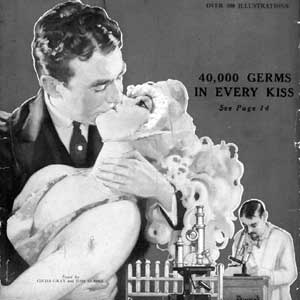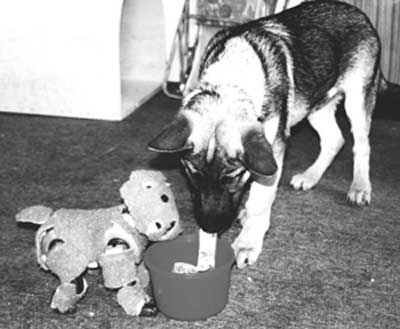Please visit our new site!
Essay
Weird science
Digging behind the sofa cushions of the research literature
4 January 2009
www.lablit.com/article/456

How many germs are in one kiss? In 1927 the magazine Science and Invention did an experiment to find out (photo © the author)
I always considered ‘news’ an overrated concept in science journalism anyway – after all, Newton is news to most people
Scientists may not be actually mad as a rule, but there is a lot of seemingly mad science out there. My work on mad science experiments originated as a by-product. During my time as the head of the science section of a now-defunct Swiss news magazine, I accumulated a stack of research studies about weird experiments. Unfortunately, my editor had no desire to see these appear in print, because they violated all the basic journalistic criteria: they were utterly inconsequential, hopelessly ancient or both.
But since I always considered ‘news’ an overrated concept in science journalism anyway – after all, Newton is news to most people – I decided to hold on to my pile of clippings. Several years later I was offered a chance to write a science column for NZZ Folio, the magazine section of a major Swiss daily newspaper. As my articles didn’t have to be related to current events and didn’t need to be important in the traditional sense, I at last found myself in a position to write about such subjects as the elixir of life being extracted from guinea-pig testicles or the first meeting between a robot dog and a real dog.
The column led to a book (The Mad Science Book and the book to a website (where you can vote for your favourite weird experiment, watch a lot of film clips, and do the weird experiments quiz.
Obviously I am not the only historian of weird science. There must be an official library category “science humour” by now and then there is the most famous Ignobel Awards. But I don’t see those people as my competitors. As a matter of fact the founder of the Ignobels, Marc Abrahams is a good friend of mine. I contribute from time to time to his website and right now he is blogging about mine.
But I think there are several differences between my approach and other projects devoted to weird science. First of all I concentrate solely on experiments. For someone interested in writing exciting stories, this choice turned out to be a fortunate one as all experiments have an inborn drama: somebody has an idea, has to find out how to test it and gets a result. Luckily for me things go wrong all the time at every stage. To learn about all the wrong turns, discarded research designs and unpublished difficulties, I always try to talk personally to the scientist involved. To my surprise, this is probably the most important difference between me and other historians of weird science: a lot of them work purely from published research. But my biggest realization is that you won’t find the really funny details in the paper.

Let’s take the famous Dr. Fox study: Can a brilliant speaker so completely bamboozle a group of experts that they overlook the fact that the content is complete nonsense? The result of the study was: yes he can. But if I hadn’t talked to the researchers I wouldn’t have found out who the speaker was. The scientists engaged Michael Fox, the actor who played the vet Dr. Benson who looked after the inspector’s dog in the television series Columbo. When he gave his talk he was very much afraid that somebody would recognize him (nobody did).
Talking with a psychologist who did research on embarrassment I found out that one participant in his experiment (who did not show up in the final study) fled the scene through the window of the restroom on the second floor of the lab building. “That was when we knew the procedure would work,” the researcher told me. The procedure turned out to be singing alone in front of a group of fellow students.
When I asked cosmonaut Boris Morukov why on earth eleven men would take part in an experiment that consisted mainly of lying in a bed day and night for 370 days he told me something about the urge to make a contribution to science. Not completely satisfied I asked again and found out that all the participants were promised a car and that only one of them quit the experiment – he already owned one.
Finding the people is a little bit like a treasure hunt. In some cases I literally had to go through phone books and call ten numbers before I hit gold. A lot of the researchers are surprised when I call them up but are very pleased that somebody has taken interest in their long forgotten work. Although a lot of the studies are very funny, I never make fun of the people.
The question people ask me most frequently is: “Where on earth do you find all these strange studies in the first place?” But in actual fact the far more interesting question is how not to find them: don’t ask the scientists. Trust me, I’ve tried. The usual answer is something like, “Nothing weird goes on in my field of research.” And if I later confront them with any strange studies I’ve unearthed, they gazed at me blankly, unable to see the humour in the psychology of car-horn honking or the economics of restaurant tipping. The fact that most experiments in this book seem odd by no means implies that they are worthless (though there’s no denying that some of them genuinely are). Others appear ridiculous only at first glance, but are in fact truly ingenious. For example, I recently did a piece about asymmetric tail wagging in dogs. That may sound truly worthless but it turns out that it is very interesting and that it allowed me to explain a lot about brain asymmetries to readers. When, in 2005, the German edition of The Mad Science Book became a bestseller, some researchers proudly announced on their websites that their experiments were in it.
So is this hobby of mine purely fun or do I seek to interest people in science? It is truly both. On the one hand it is just great to talk to all these diverse people. It is a very special feeling when I go through an old paper and realize that I am probably the first one in decades who has read it. On the other hand I really want my readers to gain some knowledge. Sometimes it’s about understanding why the experiment was done, or the context, or the deeper meaning of the result. In other cases it is about understanding the nature of science. Scientific publications often give the impression that experimentation is a linear process: researchers read the relevant literature, construct a hypothesis and design a test that then runs like clockwork. But, as a scientist once explained to me – and as the readers of my book and my website soon find – in real life, doing an experiment is rather like going to war: “On first contact with the enemy, all plans go out the window.”
